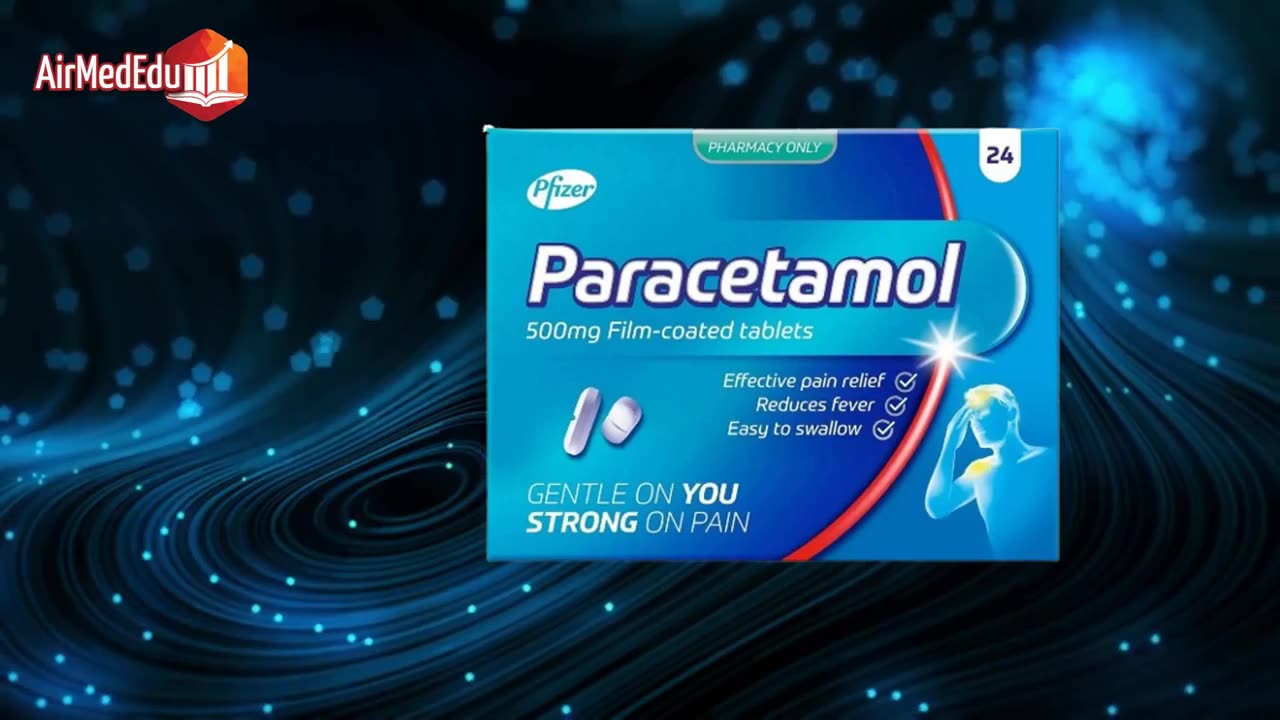Premium Only Content

Paracetamol, Recommended Dose
Paracetamol, also known as acetaminophen in some countries, is one of the most widely used analgesics and antipyretics in the world. It is found in countless homes and is prescribed or recommended to relieve mild to moderate pain and reduce fever. Its popularity stems from its accessibility, as it is sold over-the-counter in many countries, and its relatively high safety profile when used correctly. However, in a context where self-medication is common, understanding its recommended dosages is critical to avoid risks such as overdose, which can lead to serious liver damage.
Below, we will explore paracetamol comprehensively, focusing on its recommended dosages, but also addressing its history, mechanism of action, indications, side effects, interactions, and overdose management.
The history of paracetamol dates back to the 19th century, when the search for alternatives to existing analgesics fueled key discoveries in pharmaceutical chemistry. It was first synthesized in 1877 by the German chemist Karl Moritz Krause, although its therapeutic potential was not recognized at the time. A year later, in 1878, the French chemist Harmon Northrop Morse synthesized it again, but it went unnoticed for decades.
In 1893, it was identified as a metabolite of phenacetin and acetanilide, compounds used to treat pain and fever, but which proved toxic.
The real breakthrough came in the 1940s, when researchers such as Julius Axelrod and Bernard Brodie demonstrated that paracetamol was the active metabolite responsible for the analgesic effects of these precursors, but with less toxicity.
In 1955, it was launched in the United States under the brand name Tylenol by McNeil Laboratories, marking its entry into modern medicine.
A year later, in 1956, it was introduced in the United Kingdom as Panadol, and quickly spread globally.
During the 1970s and 1980s, its use became popular due to concerns about the risks of aspirin in children, such as Reye's syndrome. However, incidents such as the 1982 Tylenol mass poisoning in Chicago, where tampered capsules caused deaths, led to improvements in drug packaging.
Today, paracetamol is a mainstay in the global pharmacopoeia, with strict regulations to prevent overdoses, reflecting its evolution from a forgotten compound to an essential component in pain management.
Paracetamol acts primarily on the central nervous system, although its exact mechanism remains a subject of study. It is believed to inhibit the enzyme cyclooxygenase (COX), particularly COX-2 and a variant called COX-3 in the brain, reducing the synthesis of prostaglandins, which mediate pain and fever.
Unlike nonsteroidal anti-inflammatory drugs (NSAIDs) such as ibuprofen, it does not have a significant anti-inflammatory effect, as its peripheral action is limited.
Pharmacologically, it is rapidly absorbed from the gastrointestinal tract, reaching peak plasma concentrations in 30 to 60 minutes. Its half-life is approximately 2 to 3 hours in healthy adults, and it is primarily metabolized in the liver through glucuronide and sulfate conjugation, with a small fraction oxidized by cytochrome P450 to a toxic metabolite, N-acetyl-p-benzoquinonimine (NAPQI).
This metabolite is neutralized by glutathione, but in overdose, it depletes stores and causes liver damage.
Paracetamol readily penetrates the blood-brain barrier, explaining its effectiveness against central pain and fever. In therapeutic doses, it is safe, but factors such as alcoholism or malnutrition can alter its metabolism, increasing risks.
Recent studies also suggest modulation of descending serotonergic pathways, blocking nociceptive signals.
Paracetamol is primarily indicated for the symptomatic relief of mild to moderate pain and fever. It is effective against headaches, muscle aches, toothaches, menstrual pain, and postoperative pain, as well as in conditions such as osteoarthritis.
In pediatrics, it is the drug of choice for fever and pain in children, especially after vaccinations or viral infections.
It is also used in combination with other medications to treat colds, flu, and migraines. In adults, it is a safe alternative to NSAIDs for those with gastric ulcers or kidney problems.
In hospital settings, its intravenous form is used for moderate pain and postoperative fever.
It is not an anti-inflammatory, so it is not recommended for acute inflammations such as sprains.
Its versatility makes it ideal for all ages, but always under supervision. In pregnant women, it is considered safe at low doses, although caution is advised.
In short, its use focuses on acute symptoms, not chronic treatments, to minimize risks.
Paracetamol doses should be adjusted according to age, weight, condition, and individual response, always starting with the lowest effective dose. In adults and adolescents over 12 years of age weighing more than 50 kg, the typical dose for pain or fever is 500 mg to 1 g every 4 to 6 hours, not to exceed 4 g per day.
For rapid relief, you can start with 1 g, but for persistent pain, divide it into regular doses.
In children, dosage is based on weight for greater accuracy. For infants and toddlers, 10 to 15 mg per kg of body weight every 6 hours is recommended, not to exceed 60 mg per kg per day.
For example, a 10 kg child could receive 100 to 150 mg per dose, up to four times a day. With liquid formulations, it is crucial to use the dosing device provided to avoid errors.
For special populations, such as the elderly or patients with liver failure, the dose is reduced to a maximum of 2 g per day, with longer intervals between doses.
For pregnant women, doses should be kept low and short, avoiding exceeding 3 g per day. For children over 6 years of age, chewable tablets can be used, titrated to 325 mg every 4-6 hours.
For intravenous treatments, such as in hospitals, the starting dose for adults is 1 g every 6 hours, adjusted for weight if less than 50 kg.
For children, five doses should not be exceeded in 24 hours, and monitoring is recommended if combined with other products containing paracetamol.
Paracetamol is primarily administered orally in tablets, capsules, suspensions, or suppositories. It can be taken with or without food, although food reduces gastric irritation. Liquid forms are ideal for children, and suppositories are recommended for use when vomiting occurs.
Intravenously, it is infused slowly to avoid hypotension. Drinking plenty of water aids absorption, and avoiding alcohol is key during treatment.
Although generally well tolerated, paracetamol can rarely cause side effects such as nausea, vomiting, or skin rashes.
At high or prolonged doses, it increases the risk of liver damage, hypertension, ulcers, and heart failure, according to recent studies.
Serious reactions include Stevens-Johnson syndrome or jaundice.
It is contraindicated in cases of paracetamol hypersensitivity, severe liver failure, or active hepatitis.
Caution should be exercised in alcoholics, malnourished individuals, or those with kidney failure. Do not use for fever for more than 3 days without consulting a doctor.
It interacts with warfarin, increasing the risk of bleeding, and with hepatic induction agents such as carbamazepine, which potentiate its toxicity.
Alcohol worsens liver damage, and avoid multivitamins with paracetamol to avoid double doses.
Overdose occurs in phases: initially nausea and vomiting, then abdominal pain and jaundice, which can lead to coma or liver failure.
Treatment includes activated charcoal if recently diagnosed, N-acetylcysteine as an antidote, and hospital support.
Paracetamol is an invaluable ally against pain and fever when dosed correctly, but misuse can be dangerous. Prioritize professional consultations and read labels for safe handling. In a world of self-medication, knowledge is the best prevention for enjoying its benefits without risks.
-
 2:15:40
2:15:40
Side Scrollers Podcast
18 hours agoWTF Happened to Call of Duty?! + Ubisoft’s MAJOR F Up + Vtuber HIT LIST + More | Side Scrollers
60.1K13 -
 18:31
18:31
Nikko Ortiz
14 hours agoKaren You Need A Shower...
8.86K10 -
 9:47
9:47
MattMorseTV
16 hours ago $13.64 earnedDemocrats CAUGHT in $15,000,000 LIE.
19K29 -
 43:24
43:24
ThisIsDeLaCruz
18 hours ago $1.04 earnedWhat Fans Never Knew About Falling In Reverse’s Guitarist
6.88K -
 24:53
24:53
GritsGG
14 hours agoInsane 3998 Warzone Wins! Rank 1 Player Keeps 36 Win Streak!
8.99K -
 LIVE
LIVE
Lofi Girl
3 years agolofi hip hop radio 📚 - beats to relax/study to
259 watching -
 55:46
55:46
PandaSub2000
14 hours agoBeyond Good & Evil | ULTRA BEST AT GAMES (HD Edited Replay)
25.1K2 -
 3:11:36
3:11:36
FreshandFit
12 hours agoAlex Stein & Madison Cawthorn With Miami Latinas
210K74 -
 2:00:32
2:00:32
Badlands Media
15 hours agoOnlyLands Ep. 31: The Post-GART Hangover Show
82.8K37 -
 6:28:51
6:28:51
The Rabble Wrangler
14 hours agoBattlefield "Deputy Games" with The Best in the West!
44.3K